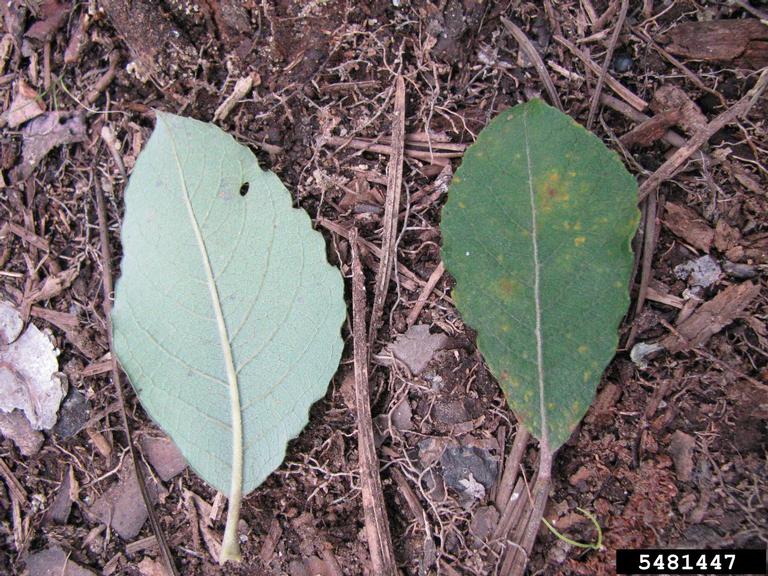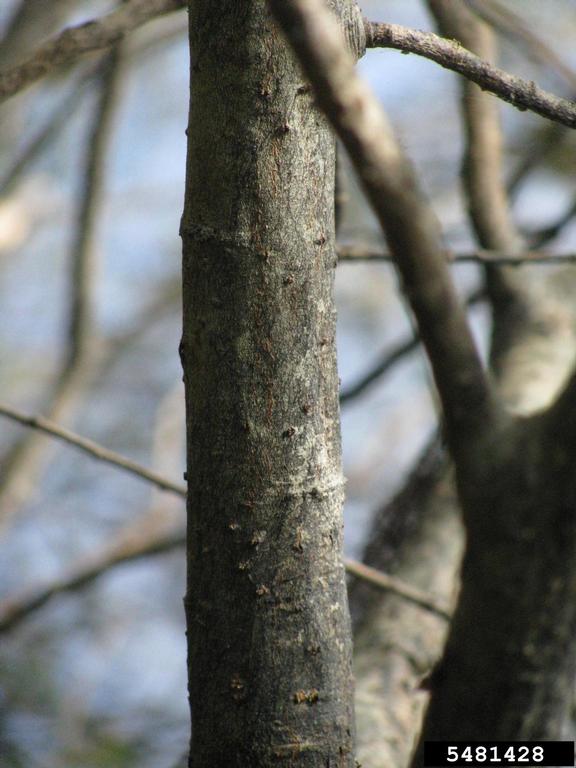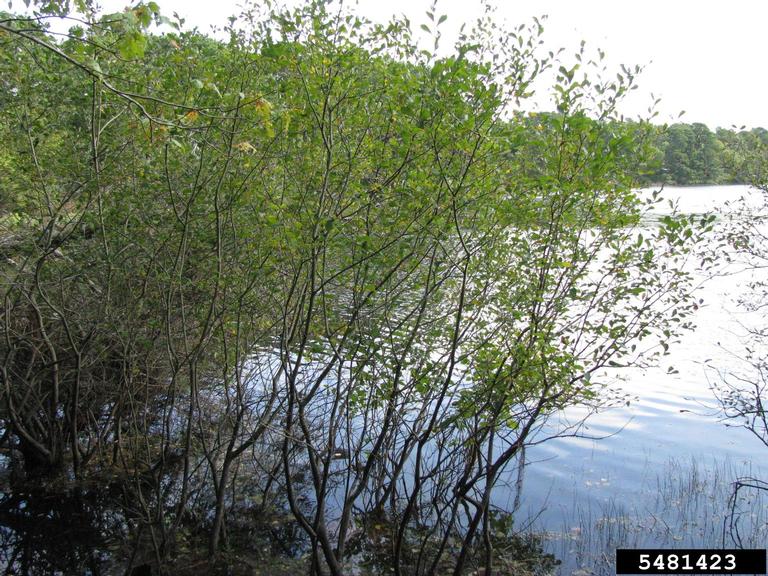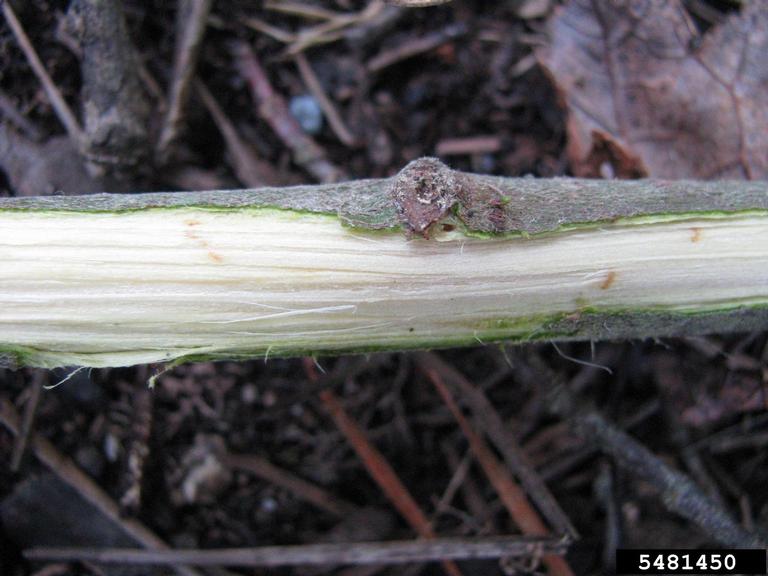Gray willow, large gray willow
(Salix atrocinerea)
Biological Category
Plants
NY Legal Status
Not Regulated
Species Type
Tree
DESCRIPTION
Gray willow is a member of the Willow family (Salicaceae).
Gray willow is a large shrub to small tree, approximately six feet in height. The bark is dark gray to brown, smooth when young, and becoming fluted and somewhat fissured with age. A relatively inconspicuous species, gray willow can be easily identified by the long ridges, or ribbing on branches and stems, easily visible when the bark is peeled away.
Note: Research for these pages was generated from citations listed. References for specific statements available upon request.
Leaves: Leaves are very variable, but usually ovate to lanceolate in shape, and are covered with soft gray hairs underneath. Leaf color can range from dark green and glossy to dull green. Margins are finely toothed, although this trait can also be variable.
Flowers: Flowers appear before leaves in March-April. Both male and female flowers are arranged on catkins up to approximately 1 inch in length.
Gray willow was intentionally introduced for riverbank stabilization and erosion prevention in the early part of the twentieth century. The species is now extant in at least 22 states.
Gray willow is tolerant of a variety of conditions and does not require consistently moist substrate to thrive. It is commonly found in riparian habitats, wet meadows and woods, ditches, and marshes in both disturbed and undisturbed locations.
A dioecious species, both male and female flowers of gray willow are pollinated by wind and insects such as bees. The species reproduces both by seed and vegetatively. Seed is dispersed with the aid of cottony hairs which catch the wind and help the seed float on water. Detached twigs and branches readily root in moist soils. One study found the species dispersed over 100 kilometers from its original source. Vectors include wind and water.
Gray willow causes major ecosystem alteration in the communities it invades. A copious producer of seed, this species hybridizes with other native willows and is capable of colonizing unique, rare habitats in New York, such as coastal plain ponds. Dense, smothering thickets of gray willow can form in relatively pristine habitats across a variety of soil types and quickly displace native species.
There is no biological control agent available at this time.
Pulling / Digging Up: Seedlings and young plants may be managed effectively by pulling, however, root fragments remaining in the soil will re-sprout.
Mowing: Mowing and cutting without the use of herbicides will encourage re-sprouting.
Girdling: Not advisable. Girdling will encourage root sprouting and suckering.
Prescribed Fire: No information available
Prescribed Grazing: No information available
Soil Tilling: Not advisable. Root fragmentation will encourage sprouting and suckering.
Mulching: Mulching may inhibit the germination of seedlings but is only feasible in garden settings or on small occurrences of this species.
Solarization: No information available
Hot Foam Spray: No information available
The pesticide application rates and usage herein are recommendations based on research and interviews with land managers. When considering the use of pesticides, it is your responsibility to fully understand the laws, regulations and best practices required to apply pesticides in a responsible manner. At times, the pest you seek to treat may not be on a pesticide label, requiring a 2ee exemption from NYSDEC. Always thoroughly read the label of any pesticide and consult the NYSDEC or a licensed pesticide applicator with questions.
Foliar Spray: A 1-2% foliar spray during growing season is effective. Always read and follow all directions on the herbicide label.
Cut Stump: Cut stump is an effective method of managing gray willow so long as all cut material is removed from the control site and chipped, crushed or thoroughly dried. Apply a 50% solution of glyphosate or triclopyr to newly cut stems.
Basal Bark: A 25% solution of triclopyr applied to the bark of dormant gray willow is effective in controlling infestations, although this technique is best applied with other strategies, such as a follow-up cut stump during the growing season.
Cut and Frill: Apply a 50% solution of glyphosate or triclopyr to cuts in gray willow’s cambium.
Stem Injection: No information available
Pre-Emergent Spray: Not applicable
General management overview and recommendation: As with any other invasive infestation complex, large stands of Gray willow are best managed via a combination of mechanical and chemical means. All managed infestations should be monitored for at least one year to manage any re-sprouting that occurs. New seedlings or vegetative growth can be hand pulled or sprayed. Larger individuals require basal bark or cut stump treatment. Even when using the most effective methods of chemical control, managed populations must be monitored due to the species’ strong tendency to form root sprouts.
Post-treatment monitoring: Controlled populations should be revisited for at least three years to ensure no re-sprouting has occurred.
Mowed, cut, or pulled Gray willow can be composted so long as management occurred prior to seed production and all material is thoroughly dried, crushed, or chipped.




